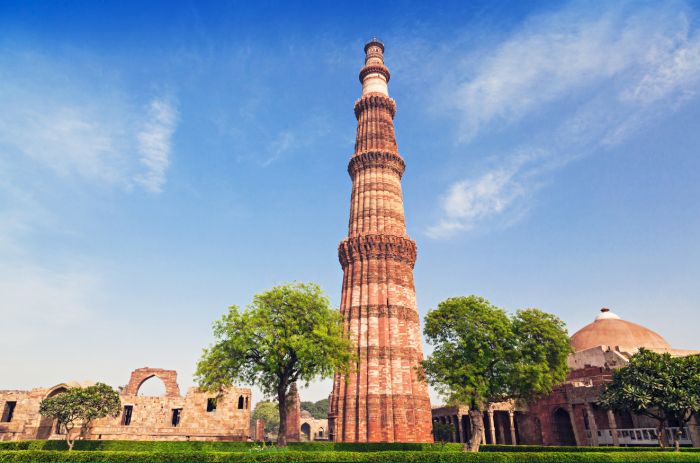
Oct 01, 24
Top Historical Sites in Delhi: A Journey Through Time
Delhi, the capital of India, is a city where history is woven into every street, monument, and corner....
Delhi, the capital of India, is a city where history is woven into every street, monument, and corner. Over centuries, it has been the seat of various dynasties, from the Mughals to the British, each leaving behind architectural marvels and stories of their time. For history enthusiasts, Delhi offers a treasure trove of experiences that span ancient, medieval, and modern eras. Let's embark on a journey through some of the top historical sites in this vibrant city.
Red Fort – The Mughal Marvel
Architectural Grandeur
The Red Fort (Lal Qila), built by Mughal emperor Shah Jahan in 1648, is one of the most iconic landmarks of Delhi. Its massive red sandstone walls stretch over 2 kilometers, standing as a testament to Mughal engineering and artistry. The fort’s intricate carvings, arches, and gardens reflect the architectural finesse of the Mughal era.
Red Fort's Historical Importance
The Red Fort was not just a royal residence but also the center of Mughal power. Today, it holds even greater significance as the site where India’s Prime Minister hoists the national flag every Independence Day. The fort’s Diwan-i-Aam (Hall of Public Audience) and Diwan-i-Khas (Hall of Private Audience) give visitors a glimpse into the life of Mughal emperors.
Qutub Minar – The Tallest Brick Minaret
A Symbol of Victory and Dominance
Standing tall at 73 meters, Qutub Minar is the tallest brick minaret in the world and a UNESCO World Heritage site. Built in 1193 by Qutb-ud-din Aibak after his victory over Delhi’s last Hindu kingdom, the tower represents the beginning of Muslim rule in India. Each story of the minaret is marked by a projecting balcony, offering breathtaking views.
Intricate Carvings and Indo-Islamic Architecture
The Qutub Minar complex is not just about the towering minaret but also includes the Quwwat-ul-Islam Mosque, one of the oldest in India. The delicate carvings on the tower and surrounding structures combine Arabic script with intricate floral patterns, showcasing a blend of Indo-Islamic architecture.
Humayun’s Tomb – A Precursor to the Taj Mahal
Mughal Architecture at Its Finest
Humayun’s Tomb, built in 1570, is another UNESCO World Heritage site and is considered a precursor to the Taj Mahal. Commissioned by Empress Bega Begum, this grand mausoleum was the first garden-tomb in the Indian subcontinent. Its symmetrical design, arched gateways, and use of red sandstone and white marble make it a masterpiece of Mughal architecture.
The Beautiful Gardens of the Tomb
Surrounding Humayun’s Tomb are charbagh gardens, divided into four parts by walkways and water channels. These beautifully landscaped gardens enhance the tomb’s serene atmosphere, making it a peaceful retreat from the bustle of Delhi.
India Gate – A Tribute to the Fallen
The Story Behind the Memorial
India Gate is a majestic war memorial dedicated to the 82,000 Indian soldiers who lost their lives during World War I. Designed by Sir Edwin Lutyens and completed in 1931, the archway stands 42 meters tall, with the names of soldiers inscribed on its walls. Beneath the arch is the Amar Jawan Jyoti, a flame that burns in honor of the fallen soldiers.
India Gate as a Popular Tourist Destination
Located in the heart of Delhi, India Gate is a favorite spot for tourists and locals alike. The surrounding lawns make it a perfect place for picnics, especially in the evenings when the monument is beautifully illuminated.
Jama Masjid – The Largest Mosque in India
A Spiritual Center of Delhi
Built by Shah Jahan in 1656, Jama Masjid is the largest mosque in India and a magnificent example of Mughal architecture. With its three grand gates, four towers, and two 40-meter-tall minarets, the mosque can hold up to 25,000 people for prayer.
The Magnificent Structure of the Mosque
The red sandstone and white marble structure of Jama Masjid is imposing yet serene. Visitors can climb to the top of the southern minaret for panoramic views of Old Delhi, offering a unique perspective on the city’s dense, lively streets.
Rashtrapati Bhavan – The Presidential Palace
British Colonial Architecture
Rashtrapati Bhavan, originally built as the residence for the British Viceroy, is now the official home of the President of India. Designed by Edwin Lutyens, it is one of the largest residences for a head of state in the world. The majestic building blends British colonial and classical Indian architectural elements, including Mughal gardens.
The Ceremonial Changing of the Guard
A unique attraction at Rashtrapati Bhavan is the Changing of the Guard ceremony, held every Saturday. The ceremony, complete with military precision, offers visitors a chance to witness the regal traditions of India's armed forces.
Lodhi Gardens – A Walk through History
Sultanate Tombs and Monuments
Lodhi Gardens is a sprawling green space in the heart of Delhi, home to several historic monuments from the Sultanate period, including the tombs of Muhammad Shah and Sikandar Lodi. These beautiful stone structures are set amidst lush lawns, making the gardens a peaceful spot to explore Delhi’s rich history.
A Peaceful Escape Amidst the History
Lodhi Gardens is a popular destination for both locals and tourists looking for a serene environment to relax and enjoy the historical setting. The combination of nature and history offers a unique way to experience Delhi’s heritage.
Purana Qila – The Ancient Fortress
A Fortress with Deep Historical Roots
Purana Qila (Old Fort) is one of the oldest forts in Delhi, with its origins tracing back to the Pandavas of the Mahabharata. The fort was later rebuilt by Humayun and Sher Shah Suri. Its imposing gates and walls stand as a reminder of Delhi’s ancient past and its strategic importance in Indian history.
The Archaeological Museum of Purana Qila
Visitors can explore the Archaeological Museum inside Purana Qila, which showcases artifacts from excavations, shedding light on Delhi’s historical and cultural evolution over millennia.
Raj Ghat – Mahatma Gandhi’s Memorial
A Peaceful Tribute to the Father of the Nation
Raj Ghat is the memorial dedicated to Mahatma Gandhi, the Father of the Nation. Situated on the banks of the Yamuna River, the black marble platform marks the spot of Gandhi’s cremation. The serene atmosphere of the memorial is perfect for quiet reflection and paying homage to one of India’s greatest leaders.
The Significance of Raj Ghat in Modern India
Raj Ghat continues to be a site of national importance, with dignitaries from around the world visiting to honor Gandhi’s legacy. Annual prayer meetings are held here on Gandhi Jayanti (October 2nd), celebrating his life and contributions.
Agrasen ki Baoli – The Hidden Stepwell
A Mysterious and Architectural Gem
Agrasen ki Baoli is an ancient stepwell hidden among the modern skyscrapers of Connaught Place. This 60-meter-long structure, with 103 steps leading down to the water, is believed to have been built during the Tughlaq or Lodi dynasty. The stepwell’s unique design and mysterious atmosphere make it a favorite among photographers and history lovers.
The Ancient Water Reservoir
Once a crucial water reservoir for the people of Delhi, Agrasen ki Baoli today stands as a reminder of the city’s ingenious engineering practices in water conservation. Its eerie charm and historical importance make it a must-visit site.
Safdarjung Tomb – The Last Mughal Garden Tomb
The Beauty of Indo-Islamic Architecture
Safdarjung Tomb is the last grand tomb built in the Mughal garden style, constructed in 1754 for Safdarjung, the Prime Minister of the Mughal Empire. The tomb’s majestic structure, with its domed roof, towering minarets, and beautiful gardens, showcases the enduring elegance of Mughal architecture.
A Symbol of Fading Mughal Glory
Though built at the tail end of the Mughal era, Safdarjung Tomb still reflects the architectural grandeur of its predecessors. The monument stands as a symbol of the declining Mughal power and a fading era of imperial glory.
Conclusion
Delhi is a city where the past seamlessly blends with the present, offering travelers a chance to step back in time and explore centuries of history, culture, and architecture. From the magnificent Mughal forts and tombs to British-era landmarks and ancient stepwells, Delhi’s historical sites are a testament to the city’s rich and diverse heritage. Whether you're a history enthusiast, an architecture lover, or a curious traveler, Delhi’s historical landmarks promise to leave you mesmerized.
FAQs
-
What is the best time to visit Delhi's historical sites?
The best time to visit is during the cooler months, from October to March, when the weather is pleasant for sightseeing. -
Are there any entry fees for Delhi’s historical sites?
Yes, most historical sites like Red Fort, Qutub Minar, and Humayun’s Tomb have entry fees, with different rates for Indian and foreign tourists. -
Can I visit these sites in one day?
While it’s possible to visit a few key sites in one day, to fully appreciate Delhi’s rich history, it’s recommended to spread your visits over several days. -
Is there a guided tour available for these historical landmarks?
Yes, guided tours are available at most of the major historical sites, and some offer audio guides as well.
